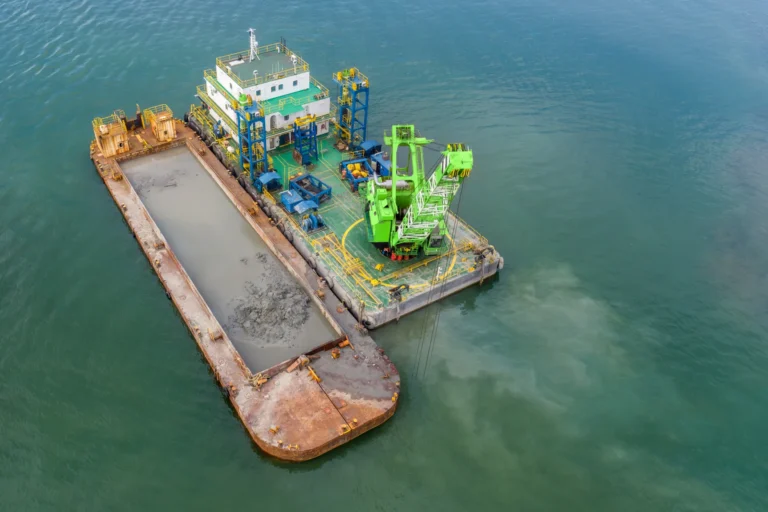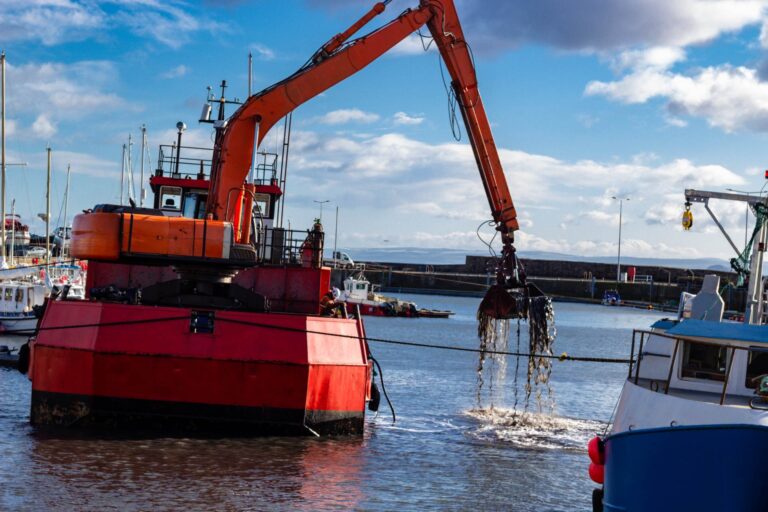Mechanical dredging is a widely used method for removing sediment, debris, and other materials from water bodies to maintain navigable waterways, ports, and harbors. This process involves using heavy equipment, such as clamshell dredgers, bucket dredgers, or backhoes, to excavate and remove sediment directly. It is especially effective in areas requiring precise sediment removal or where compacted materials are present.
The two methods differ significantly in their processes and applications. While hydraulic dredging uses suction pumps to transport sediment as a slurry through pipelines, mechanical dredging physically removes material in solid form and loads it onto barges for disposal or reuse. Hydraulic dredging is often preferred for large-scale projects involving high sediment volumes, whereas mechanical dredging is better suited for smaller, targeted projects or where greater precision is required.
This blog explores the advantages of mechanical dredging, highlighting its strengths, such as precision, flexibility, and the ability to handle compacted materials. It also delves into its limitations, including slower processes for large areas and potential environmental impacts. By understanding both the benefits and challenges of this method, stakeholders can make informed decisions when selecting the most appropriate dredging solution for their specific needs.
What is Mechanical Dredging?
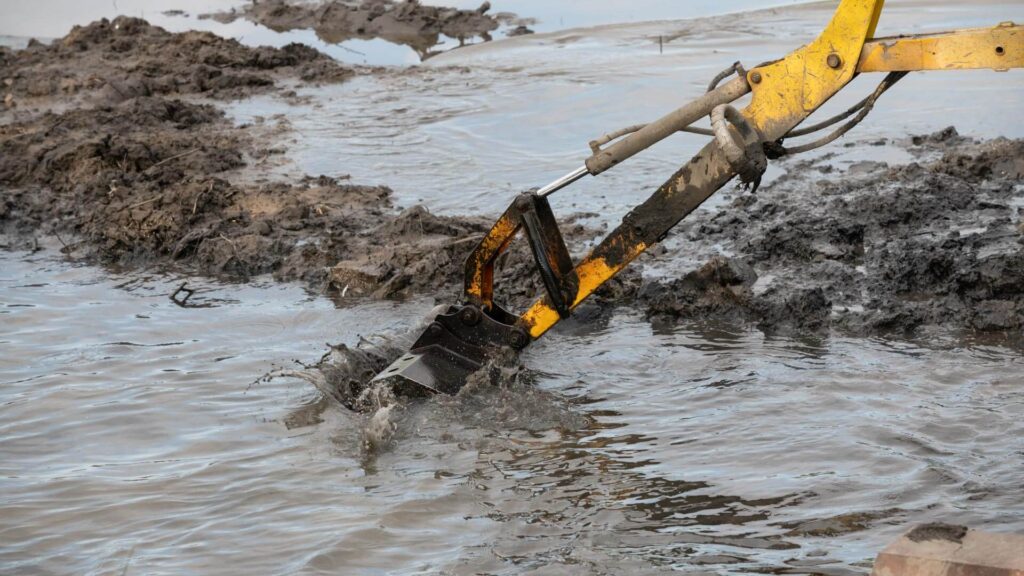
Mechanical dredging is a method of removing sediment, debris, and other materials from water bodies using specialized equipment that excavates and physically removes material in its solid form. This process is particularly effective in projects that require precision and the removal of compacted or dense materials, making it an essential tool in waterway maintenance and restoration.
The mechanical dredging process involves deploying heavy machinery to dig or scoop sediment from the bottom of a water body; unlike hydraulic dredging, which uses suction pumps to transport sediment as a slurry through pipelines, mechanical dredging loads the excavated material onto barges for transportation to a designated disposal or reuse site. This distinction often makes mechanical dredging more suitable for targeted, smaller-scale projects, which highlights one of its key advantages.
There are several types of equipment used in mechanical dredging, each suited to specific project needs:
- Clamshell Dredgers: These are equipped with a large bucket-like mechanism that opens and closes to scoop sediment. They are ideal for precise sediment removal in confined spaces.
- Bucket Dredgers: These machines use a series of buckets attached to a chain to excavate sediment continuously, making them suitable for repetitive dredging tasks.
- Backhoe Dredgers: These machines function similarly to a land-based backhoe, using an articulated arm to dig and remove compacted materials effectively.
Mechanical dredging is most effective in situations requiring high precision, such as removing contaminated sediment, operating in confined waterways, or excavating dense materials. When compared to hydraulic dredging, the mechanical approach offers greater accuracy, especially in complex or small-scale environments. This precision is one of the significant advantages of mechanical dredging, making it an indispensable technique for certain dredging projects.
Advantages of Mechanical Dredging
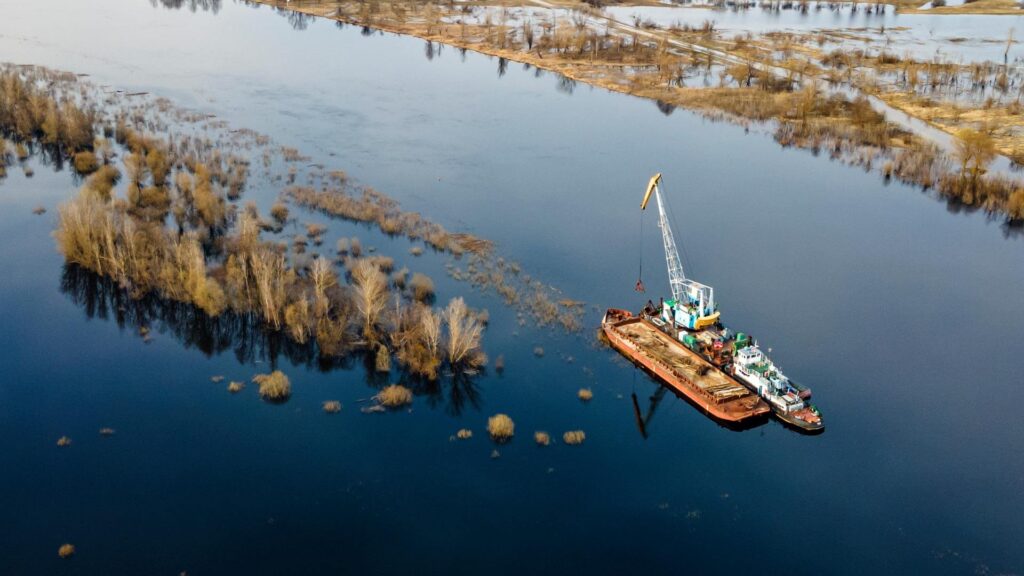
Mechanical dredging offers several distinct benefits that make it a preferred choice for certain types of dredging projects. These advantages stem from its precision, flexibility, and ability to handle specific materials and conditions. When compared to hydraulic dredging, mechanical methods excel in situations requiring targeted excavation and adaptability.
High Precision
One of the most notable advantages of mechanical dredging is its ability to achieve high precision. Mechanical dredging equipment, such as clamshell or backhoe dredgers, can excavate specific areas with minimal disruption to surrounding environments. This precision makes it ideal for confined spaces, such as narrow canals, harbors, or areas with structures nearby, where precise sediment removal is critical.
Effective for Dense or Hard Materials
Mechanical dredging is particularly effective at removing compacted sediments, rocks, and debris that might pose challenges for hydraulic methods. The ability to physically excavate and lift these materials ensures efficient removal, especially in areas with tough or consolidated sediment layers. This feature highlights another key advantage of mechanical dredging over its hydraulic counterpart in certain applications.
Flexibility in Sediment Disposal
Unlike hydraulic dredging, which requires pipelines to transport sediment as a slurry, mechanical dredging allows for direct placement of dredged material into barges. This flexibility simplifies transportation and disposal, enabling efficient handling of materials over long distances.
No Need for Extensive Pipeline Infrastructure
Another advantage of mechanical dredging is that it eliminates the need for extensive pipeline networks, reducing setup time and costs. This feature makes mechanical dredging a practical option for smaller or isolated projects.
These advantages of mechanical dredging demonstrate its value in precise and specialized applications, offering solutions for unique challenges that hydraulic methods might not address as effectively. The comparison of hydraulic vs mechanical dredging underscores the importance of selecting the right method for specific project requirements.
Hydraulic vs Mechanical Dredging
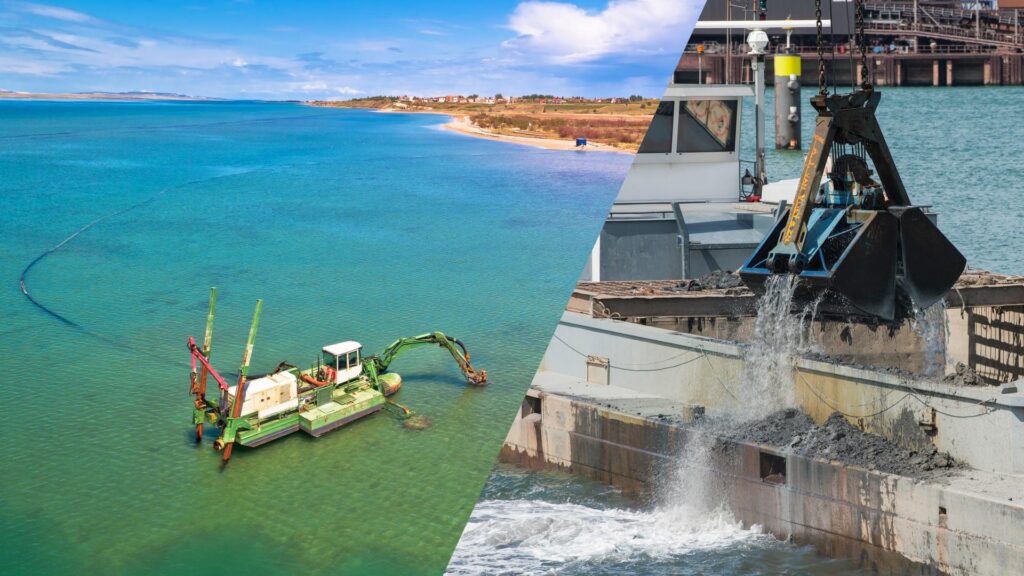
Hydraulic and mechanical dredging are two primary methods of waterway maintenance, each with distinct processes, equipment, and applications. Understanding the differences between hydraulic vs mechanical dredging is essential for selecting the right approach for specific projects.
Processes and Equipment
Hydraulic dredging involves using suction pumps to remove sediment and transport it as a slurry through pipelines to designated disposal or reuse areas. This method is highly efficient for large-scale sediment removal and projects requiring continuous operation over long distances. In contrast, mechanical dredging uses equipment like clamshells, buckets, or backhoe dredgers to excavate sediment in solid form and place it directly onto barges for transport. The choice between hydraulic vs mechanical dredging depends on factors like project scale, material type, and site conditions.
Applications
Hydraulic dredging excels in large-scale projects, such as maintaining deep ports, harbors, and large waterways, where vast amounts of sediment need to be removed quickly and transported over long distances. On the other hand, the advantages of mechanical dredging make it ideal for smaller-scale projects, confined areas, or situations where accuracy is critical, such as clearing contaminated sediment or working in narrow canals. The choice between hydraulic vs. mechanical dredging often depends on project requirements, including scale, site conditions, and the type of material being removed.
Examples of Project Preferences
For example, a large harbor dredging project requiring the removal of millions of cubic meters of sediment might favor hydraulic dredging due to its efficiency. Conversely, dredging a narrow river with hard sediment layers would highlight the advantages of mechanical dredging, as the equipment can precisely excavate the targeted area without extensive infrastructure.
The comparison of hydraulic vs mechanical dredging underscores the importance of tailoring dredging methods to specific site conditions and project goals. While hydraulic methods offer speed and efficiency, the advantages of mechanical dredging lie in its precision, flexibility, and ability to handle dense materials effectively.
Limitations of Mechanical Dredging
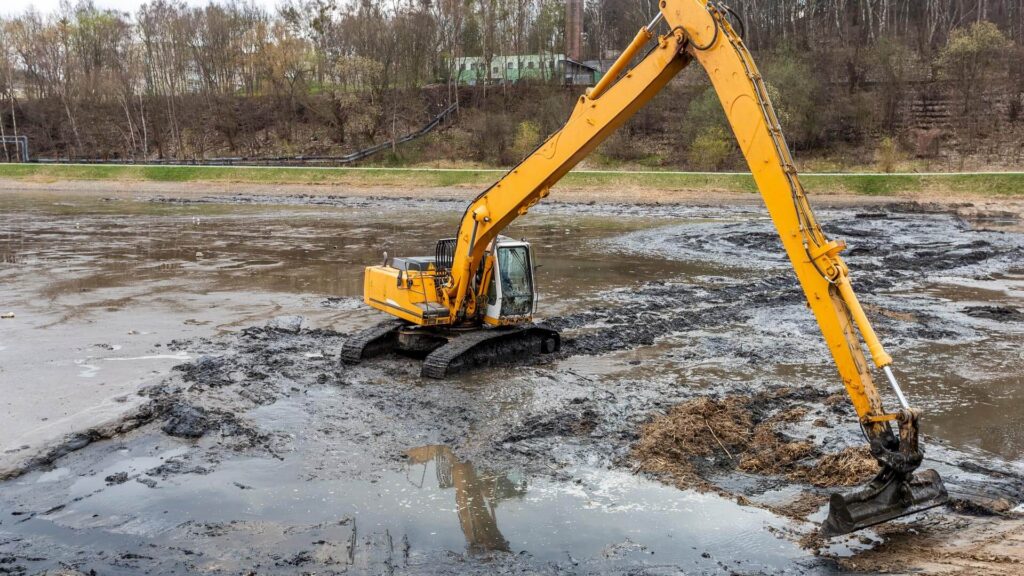
While mechanical dredging offers several advantages, it also has limitations that make it less suitable for certain projects. When comparing hydraulic vs. mechanical dredging, mechanical dredging is clearly better suited for specific situations, but its drawbacks must be considered when planning large-scale or complex operations.
Slower Process for Large Areas
One significant limitation of mechanical dredging is its slower pace when dealing with large-scale sediment removal. Unlike hydraulic dredging, which can continuously transport large volumes of sediment as a slurry, mechanical dredging relies on equipment to excavate physically and transport material in smaller loads. This makes it less efficient for high-volume projects, where speed and scale are critical. Despite its advantages in precision, its inefficiency for expansive areas remains a drawback.
Environmental Impact
Mechanical dredging can cause sediment resuspension, which increases water turbidity. This can disrupt aquatic ecosystems and affect water quality, particularly in sensitive environments. Proper planning and mitigation measures are essential to reduce these impacts.
Higher Labor Costs
Compared to hydraulic dredging, which often relies on automated systems, mechanical dredging requires more personnel for operation and logistics. The need for skilled operators, barge crews, and support staff can significantly increase labor costs.
Depth Constraints
Mechanical dredging equipment is less effective in very deep water. Hydraulic dredging systems, which transport sediment through pipelines, are better suited for deeper environments.
The advantages of mechanical dredging make it a valuable tool in specific scenarios, but its limitations highlight the importance of carefully assessing project requirements when choosing between hydraulic and mechanical dredging methods.
Applications of Mechanical Dredging in Waterway Maintenance
Mechanical dredging is a versatile method used in various waterway maintenance projects. Its ability to provide precision and handle dense materials makes it a preferred choice in certain scenarios. Compared to hydraulic dredging, mechanical dredging is especially effective in areas requiring targeted sediment removal or where confined spaces present logistical challenges.
Port and Harbor Maintenance
Ports and harbors frequently require maintenance to ensure navigability for ships. Mechanical dredging is ideal for removing silt, debris, and compacted sediment from these areas with precision. The ability to directly load dredged materials onto barges facilitates quick disposal or relocation, making it a practical solution for busy harbor environments. The advantages of mechanical dredging in ports include minimal disruption to surrounding areas and precise sediment removal.
River and Canal Dredging
Mechanical dredging is particularly effective in confined waterways, such as rivers and canals. The equipment’s ability to work in narrow spaces and excavate hard materials ensures efficient sediment removal, helping to maintain water flow and prevent flooding. Compared to hydraulic vs mechanical dredging, mechanical methods are often more suitable in these constrained environments.
Environmental Restoration Projects
Mechanical dredging is crucial for accurately removing contaminated sediments in environmental restoration. This precision reduces the risk of spreading pollutants and allows for safer disposal or treatment. Projects targeting polluted riverbeds or industrial lagoons often rely on mechanical dredging to achieve their goals.
Examples of Successful Projects
Mechanical dredging has been effectively employed in projects such as clearing sediment in the Panama Canal and restoring contaminated industrial waterways in urban areas. These examples highlight its adaptability and reliability in diverse waterway maintenance tasks.
Overall, the advantages of mechanical dredging make it indispensable in scenarios requiring precision, flexibility, and targeted sediment removal.
Innovations in Mechanical Dredging
Recent innovations in mechanical dredging are revolutionizing its efficiency and environmental sustainability. These advancements address some of its traditional limitations while enhancing its overall performance. Compared to hydraulic dredging, mechanical methods have benefited significantly from modern equipment design, automation, and hybrid solutions, further emphasizing its advantages.
Modern Equipment Design
Advancements in dredging equipment have focused on improving precision and reducing environmental impact. New buckets and clamshell dredgers are designed to minimize sediment resuspension, protecting aquatic ecosystems during dredging operations. Enhanced materials and designs have also improved the durability and efficiency of mechanical dredging tools, enabling longer operation times with less maintenance. These developments highlight the advantages of mechanical dredging.
Automation and AI-Driven Solutions
Automation and artificial intelligence are transforming mechanical dredging. Automated dredgers equipped with AI-driven monitoring systems can execute precise excavation with minimal human intervention, reducing labor costs and increasing operational efficiency. Real-time data analysis helps operators make informed decisions, further optimizing the dredging process. When comparing hydraulic vs mechanical dredging, automation is closing the efficiency gap between the two methods while retaining the precision benefits of mechanical dredging.
Hybrid Methods
In some projects, combining mechanical and hydraulic dredging offers the best of both worlds. Mechanical dredging can target dense or compacted sediments, while hydraulic dredging efficiently removes bulk sediment. These hybrid approaches maximize efficiency and address a wider range of project requirements.
These innovations in mechanical dredging continue to refine its performance and sustainability, making it a versatile and valuable method in waterway maintenance. They further underscore the ongoing advantages of mechanical dredging in diverse applications.
Conclusion
Mechanical dredging remains an essential method for maintaining waterways, offering precision, flexibility, and effectiveness in specific scenarios. Its advantages, such as high precision, the ability to handle dense materials, and flexibility in sediment disposal, make it a preferred choice for smaller-scale projects or confined spaces. However, its limitations, including slower processes for large-scale operations and potential environmental impacts, highlight the need for careful consideration of project requirements.
When comparing hydraulic vs mechanical dredging, it becomes clear that each method has its strengths and is suited for different applications. Hydraulic dredging excels in large-scale sediment removal projects, while mechanical dredging is ideal for targeted and precise excavation.
Choosing the right dredging method involves evaluating factors such as project scale, sediment type, and environmental sensitivity. Exploring sustainable and innovative solutions, such as automation and hybrid approaches, can further optimize dredging operations while minimizing environmental impact.
By leveraging the strengths of each method and incorporating modern advancements, mechanical and hydraulic dredging can continue to play a vital role in maintaining waterways and supporting environmental restoration.




